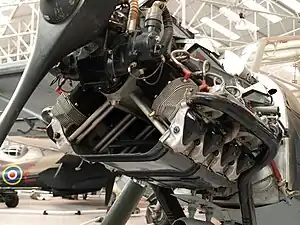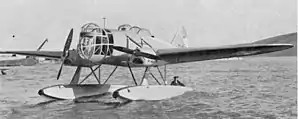Rogožarski SIM-XIV-H
The Rogožarski SIM-XIV-H (Serbian: Рогожарски СИМ-XIV-Х) was a 1930s Yugoslav coastal reconnaissance floatplane and light bomber, twin-engined, with three crew members. It was designed and built at the Rogožarski factory in Belgrade.[2]

| Rogožarski SIM-XIV-H | |
|---|---|
 | |
| Role | Reconnaissance floatplane |
| National origin | Yugoslavia |
| Manufacturer | Prva Srpska Fabrika Aeroplana Zivojin Rogožarski A.D., |
| Designer | Sima Milutinović |
| First flight | 8 February 1938 |
| Introduction | 1939 |
| Retired | 1942 |
| Status | inactive |
| Primary user | Yugoslav Royal Navy |
| Produced | from 1939 to 1941 |
| Number built | 19[1] |
Design and development
In January 1937, the Yugoslav Navy Air Service issued a specification for a twin-engined coastal reconnaissance aircraft,[3] to replace the Ikarus IO flying boat.
To meet this requirement, Rogozarski proposed the SIM-XIV-H, a twin-engined floatplane designed by Sima Milutinović, and this type was selected by the Yugoslav navy, with the first prototype making its maiden flight on 8 February 1938.[3]
The SIM-XIV-H was a low winged monoplane of mixed wood and metal construction, with an oval section monocoque fuselage. The wing was braced to the fuselage by steel-tube struts, with the tail also braced. It had a glazed nose, with a gun turret armed with a single machine gun mounted above the nose. The pilot and radio operator/gunner sat in tandem under a long canopy, with the observer also armed with a single machine gun.[4] The rear fuselage was fabric covered, while the moving tail surfaces were metal clad. The elliptical wing was of wooden construction, and was clad in plywood. It was powered by two 240 hp (179 kW) Argus As 10C air-cooled V8 engines driving fixed two-bladed propellers, also designed by engineer Sima Milutinović. Two Alclad floats made by the EDO Corporation were attached to the engine nacelles and fuselage.[5][6]
The basic aircraft weapons were anti-submarine bombs, of which the plane could carry one 100 kg bomb or two 50 kg. For anti-personnel action the plane could carry 12 fragmentation bombs massing 12 kg each. Typically, the aircraft was armed with two machine guns on board: one placed in the nose to by operated by the observer and the other in the rear gunner's cockpit. Bombsights were made in Yugoslavia and the bombing of Viro in low flight also Brilet local sights.[7]
Testing of the prototype was successful, with the aircraft demonstrating good handling, and the type was ordered into production. The first batch of six SIM-XIV-H, known as the Series O, differed from the prototype in having the turret removed from the nose and the tail modified. The second batch of six aircraft, the Series 1, had a cantilever wing, eliminating the bracing between the wing and the fuselage, and had 270 hp (201 kW) Argus As-10 engines driving metal two-pitch propellers.[8]
A third batch of 12 aircraft was ordered in 1940, with 450 hp (336 kW) Argus As 410, but construction was interrupted by the German invasion of Yugoslavia in 1941. Plans for a landplane trainer adaptation of the SIM-XIV-H were also abandoned.[9]
Operational history
All the SIM-XIV-H and SIM XIVB-Hs were deployed to the naval bases at Divulje (near Split) and Kumbor (Kotor). Before Yugoslavia entered the war, they were used to carry out the duties for which they were designed, with intense training activity due to the approaching threat of war. In that period, three aircraft were destroyed, with 16 aircraft remaining in service when the Germans invaded Yugoslavia
These aircraft were used in the April war in operations against the Germans and Italians along the Adriatic coast, carrying out reconnaissance and aiding mining operations. Five aircraft were destroyed in the fight against the attacking forces. Four aircraft attempted to escape to Greece, of which two were destroyed and two reached British bases in Egypt via Crete. These two aircraft were used for reconnaissance missions over the Mediterranean Sea until one was lost and the other scrapped because of lack of spares. Italy seized a total of eight aircraft, a SIM-XIV-H and 7 SIM-XIVB-Hs. One specimen was immediately transferred to the Test Center at Vigna di Valle, where it showed better results than found in testing in Yugoslavia while the others were transferred to the aeronautical school at Orbetello, continuing in use for training and communications purposes until the end of 1942.[1][9][10]
Operators
- Royal Yugoslav Navy - 19 aircraft
- Regia Aeronautica - 8 aircraft
- Royal Air Force - 2 aircraft.
Variants
- Rogožarski SIM-XIV-H
- First variant with two Argus As-10C engines 240 hp, six built in 1939
- Rogožarski SIM-XIVB-H
- Second variant with two Argus As-10E engines 270 hp, 12 built in 1940.
Specifications
Data from Станојевић, Д.; Јанић, Ч; (12/1982.). "Животни пут и дело једног великана нашег ваздухопловства - светао пример и узор нараштајима" (in (Serbian)). Машинство (-{YU}--Београд: Савез инжењера и техничара Југославије) 31: 1867 - 1876.
General characteristics
- Crew: 3
- Length: 11.20 m (36 ft 9 in)
- Wingspan: 15.20 m (49 ft 10 in)
- Height: 4.48 m (14 ft 8 in)
- Wing area: 37.56 m2 (404.3 sq ft)
- Empty weight: 2,230 kg (4,916 lb)
- Gross weight: 3,350 kg (7,385 lb)
- Powerplant: 2 × Argus As-10c (Argus As-10e) 8-cylinder V-line, 180 kW (240 hp) each
Performance
- Maximum speed: 208 km/h (129 mph, 112 kn) 243 at sea level
- Minimum control speed: 93 km/h (58 mph, 50 kn)
- Range: 840 km (520 mi, 450 nmi)
- Service ceiling: 4,340 m (14,240 ft)
- Rate of climb: 3.87 m/s (762 ft/min) to 1,000 m (3,281 ft)
Armament
- guns: 2x7,9 mm
- bombs: 1 х 100 kg; or 2 x 50 kg; or 12 x 12 kg
See also
Aircraft of comparable role, configuration, and era
Related lists
Notes
- Петровић, O. (2004). Војни аероплани Краљевине СХС/Југославије (Део II: 1931–1941.). Београд: МВЈ Лет 3.
- "Рогожарски СИМ-XIV-Х". Vazduhoplovnetradicijesrbije.rs. Retrieved 2016-11-29.
- Green 1962, p. 201.
- Green 1962, pp. 201–203.
- Станојевић, Д.; Јанић, Ч; (12/1982.). "Животни пут и дело једног великана нашег ваздухопловства - светао пример и узор нараштајима" (in (Serbian)). Машинство (-{YU}--Београд: Савез инжењера и техничара Југославије) 31: 1867 - 1876.
- "JP's Panzers Wargame & History Forums • View topic - Rogozarski SIM-XIV-H". Panzercentral.com. Retrieved 2016-11-29.
- Isaić & Frka 2010, pp. 73-91
- Green 1962, pp. 203–204.
- Green 1962, p. 204.
- "Rogozarski SIM.XIV". Airwar.ru. Retrieved 2016-11-29.
References
- Green, William (1962). War Planes of the Second World War: Volume Six Floatplanes. London: Macdonald.
- Grey, C.G. (1972). Jane's All the World's Aircraft 1938. London: David & Charles. ISBN 0-7153-5734-4.
- Gunston, Bill (1989). World Encyclopaedia of Aero Engines (2nd ed.). Wellingborough: Patrick Stephens Ltd. ISBN 1-85260-163-9.
- Isaić, Vladimir; Frka Danijel (2010). "Hidroavion Rogožarski SIM XIV-H". Naval Aviation at the Eastern Coast of the Adriatic Sea 1918-1941 (Volume 1). Zagreb: Tko zna zna. pp. 73–91. ISBN 978-953-97564-6-6.
- Isaić, Vladimir (August 1994). "Le Rogozarski SIM XIV-H". Avions: Toute l'aéronautique et son histoire (in French) (18): 34–39. ISSN 1243-8650.
- Janić; O. Petrović, Čedomir (2011). Short History of Aviation in Serbia. Beograd: Aerokomunikacije. ISBN 978-86-913973-2-6.
- Станојевић, Драгољуб.; Чедомир Јанић (December 1982). Животни пут и дело једног великана нашег ваздухопловства - светао пример и узор нараштајима. Машинство (in Serbian). Београд: Савез инжењера и техничара Југославије. 31: 1867–1876.
- Петровић, Огњан М. (March 2004). Војни аероплани Краљевине СХС/Југославије (Део II: 1931–1941.): СИМ XIV-Х. Лет [Flight] (in Serbian). Београд: Музеј југословенског ваздухопловства. 3: 70–71. ISSN 1450-684X.
- Jovannović, dr. Branislav (2002). "Vazduhoplovna industrija Jugoslavije (I): Ratne mašine". Аеромагазин (in Serbian). Београд. Бр.52: 26–28.
- Оштрић, Шиме; М. Мицевски (14–27 September 2007). Летећи Чунови: Чамци који лете - летјелице које плове (in Serbian). Београд: Галерија '73.
External links
- Рогожарски СИМ-XIV-Х
- Rogozarski SIM-XIV-H panzercentral.com
- "Sim xiv h" (in Serbian). Archived from the original on 2011-10-04. Retrieved 2010-07-23.